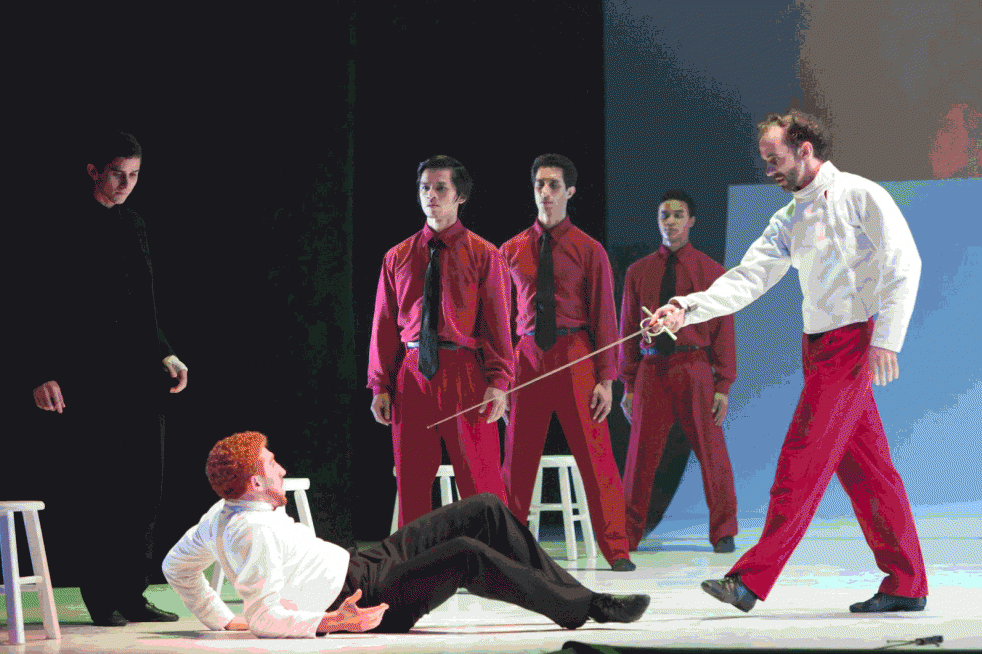Recreating a classic story “in dance” or “on ice!” is too often an excuse for what is, at worst, pure gimmickry or, at best, a scenario where style takes precedence over substance. Stephen Mills’ Hamlet, performed by the Atlanta Ballet, breaks through this usual ceiling, creating an ethereal atmosphere that stays true to its foundation while leaving room for fanciful interpretation.
While not created uniquely for this production, the musical score by Philip Glass is the most powerful standout in the performance. Filled with pieces that represent Glass’ classic minimalist style, the music defines and enlivens the tone of the performance.
Whether it is the harsh tones present during Hamlet’s descent into madness or the haunted whispers at Ophelia’s funeral, this soundtrack is as much a character as the cast itself. The violin concerto that dominates the second act is notably euphonic yet tense during particularly grueling moments of the performance.
Of course, the heart of any ballet is the choreography. While the music is modern, the choreography is an integration of traditional ballet with the raw expressionism of modern dance. It is not always easy on the eyes and for good reason: Hamlet is a play about madness in all of its forms.
The powerful, spastic movements during Hamlet’s hallucinations and breakdowns contrast with the more elegant moments found in Hamlet and Ophelia’s courtship and the performances during the coronation.
The choreography for the stage combat is equally powerful, creating a fight scene that somehow manages to be tense and suspenseful despite its foregone conclusion.
The sets are another standout. The whole performance bursts with surrealism, understandably because it takes place in a story where the line between truth and delusion is non-existent.
Hamlet’s dream sequences early in the show resemble that of a mad scientist and his horrors, the ghost of his father and his own doppelgangers.
Other scenes are just as impressive. Ophelia’s psychological breakdown has never been so beautiful, the decline of a young, innocent mind into the comfort of pleasant violet auras and flowery dreams.
Her funeral is just as elegiac, set against the backdrop of a wintry landscape set to soft, whistling tunes and the feeling, if not reality, of comfort and finality in the deep blanketing snow.
The story of Hamlet is so core to the Western canon that many know it subconsciously. Hamlet, the Prince of Denmark is melancholy after the death of his father and the ascension of his uncle, Claudius, to the throne. One night he receives an earful from the spirit of his deceased dad and is told that it was in fact Claudius who murdered him.
Hamlet, through a combination of angst, degenerative psychosis and deep-seated sexual frustration, embarks on a path to killing Claudius while inadvertently destroying the lives of everyone around him, including his friends, girlfriend and the rest of his family.
The ballet functions as kind of greatest-hits reel of Shakespeare’s original work. The story begins with the opening coronation of Claudius and quickly cuts away to Hamlet’s nightmares of his father.
After that, it cuts to the play-within-a-play where Hamlet attempts to expose Claudius’ treachery.
The second act focuses primarily on just two scenes: the death of Ophelia, which is not present in all adaptations and the final duel between Hamlet and his enemies. Along the way, the transitions between these key sequences are peppered with abstract, dream-like dances between Hamlet and the other characters.
For a work as nuanced and over-analyzed as Hamlet, it is nearly impossible to capture its political and psychological subtleties in a production that is all dance and no-dialogue. Nonetheless, while the ballet may not capture the story of Hamlet, it certainly captures the feel.
This is not a play for newcomers. The ballet assumes the audience is already well-versed in Hamlet’s story. In particular, the lack of dialogue makes it impossible to know what is happening without knowledge of the entire story beforehand.
Even with that knowledge, there are some sequences where it is difficult to know whether what is occurring on stage is meant to be emotional and abstract or concrete and plot-related.
The lack of dialogue also means that in the first third of the performance, it is a bit of a struggle to figure out who is playing what character.
This is a performance at the peak of style in terms of dance, music and set design.
For the audience already knowledgeable in Shakespeare, most issues with story simplification are easily overcome in the first third of the show.
Newcomers may find themselves too lost in the aesthetics to realize exactly what is going on. However, with a sensory assault this sublime, that is not necessarily a bad thing.
